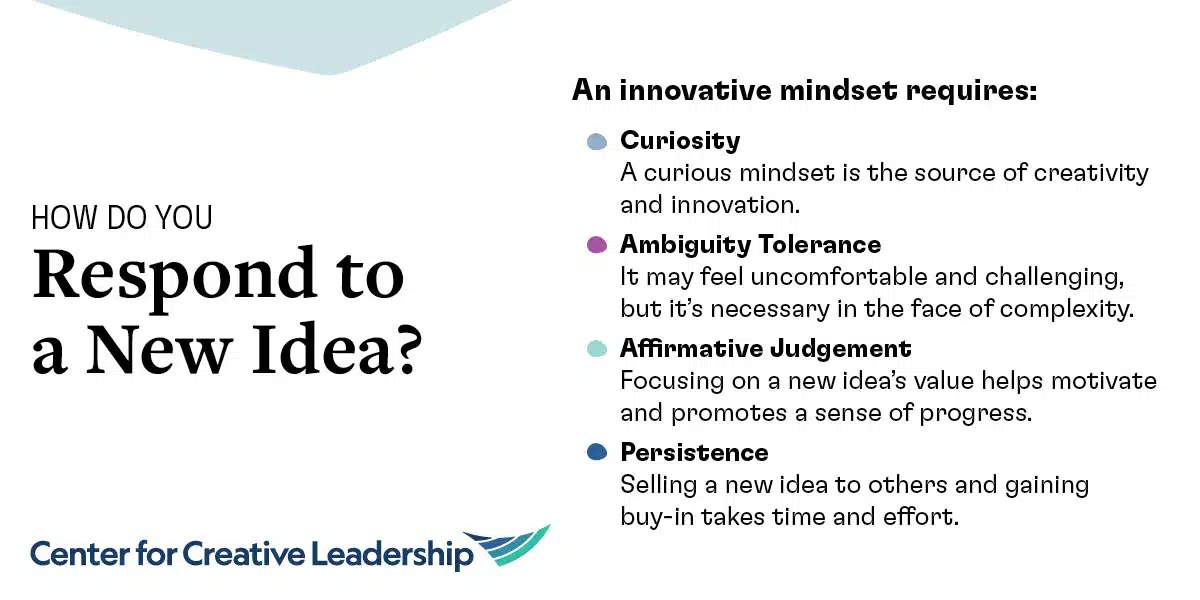How Do You Respond to a New Idea?
What happens at work when you’re presented with a new idea?
Do you play devil’s advocate, punching holes in the idea or pointing out roadblocks? Do you shut it down with a quick retort or dismissive gesture? Or do you ignore it, hoping the idea (and the person who had it) will just go away?
What a leader says and does when someone comes to them with an idea can either spur innovation or stifle it. In fact, studies show that up to 67% of the climate for creativity in organizations is directly attributed to the behavior of the leader.
Caution, skepticism, judging, and dismissal are understandable — and typical — responses to new ideas, especially when resources are strapped. Yet they’re also signs of subconsciously sabotaging innovation and the development of innovative mindsets. In order to foster trust, creativity, collaboration, and innovation within and across teams, you must work to create a psychologically safe culture where team members feel comfortable sharing their ideas. These unfiltered ideas are what lead to innovation.
What Does an Innovative Mindset Require?
To counter this natural tendency and to foster innovation in their teams and among their direct reports, leaders can develop an innovative mindset — along with learning innovation processes, tools, and skills.
What’s an innovative mindset exactly?
Leaders who have an innovative mindset:
- Have curiosity;
- Are able to tolerate ambiguity;
- Practice affirmative judgment; and
- Show persistence.
4 Facets of an Innovative Mindset
1. Stay curious.
People who are good at making things happen are curious. Curiosity fuels the acquisition of new information and is the source of creativity and innovation.
Innovation leaders are curious about why things are set up the way they are, open to doing things differently, and willing to try things that don’t neatly fit into their own assumptions. Curious leaders ask, What if? or How might we do something different? They shift their focus from, There’s no way we can do that! to I wonder how we could make that happen.
When you feel you already know the answer, there’s no curiosity.
2. Be tolerant of ambiguity.
Ambiguity is uncomfortable and challenging. But the ability to slow down and be okay with ambiguity is necessary to innovate in the face of complexity.
Innovation leaders balance the need to move forward with the need to hold themselves open to options. Creative thinking and innovative solutions increase when leaders are willing to stay open to possibilities longer.
3. Practice affirmative judgment.
Instead of telling people what they don’t like or what won’t work, innovation leaders let people know what they do like. They point out the strengths and value of a new solution or idea. This lets the team know they’re on to something new and useful, and it ensures they retain the most valuable attributes as the idea evolves.
Affirmative judgment also provides recognition and promotes a sense of accomplishment and progress, which employees need to keep them motivated.
4. Remain persistent.
By definition, new ideas are strange, unusual, weird, and different. So selling new ideas to others to get buy-in takes a lot of work and time.
A senior leader once told his people that if they propose an idea and he says “no,” don’t give up. If they still believe in the idea, he told them he wanted them to try another way to pitch it until he sees its value. For him, that was the definition of “empowerment.”
Innovation leaders empower themselves to do what it takes, which typically requires great persistence.
Innovation and innovative mindsets don’t happen without leadership. Regardless of the brilliance of your strategy, remember that the culture will support it or kill it. Since leaders have such a significant impact on the culture, it’s up to you as the leader to develop it.
The next time you hear a new idea or are asked to weigh in on a new solution, make a choice to lead with an innovative mindset, and foster innovation.
How Do You Encourage an Innovative Mindset on Your Team?
In our book How to Treat New Ideas, the authors draw on decades of personal experience, data, and lessons from scores of organizations around the world.
They identify 5 tips that can help leaders nurture new ideas and foster innovative mindsets in the workplace.
5 Tips to Foster an Innovative Mindset
1. Resist the instinct to kill a new idea.
Leaders need to understand that their first reaction to a new idea is typically “fight or flight.” When an idea that is new, foreign, or maybe even odd emerges, we’re programmed to fight it or resist it, perhaps maybe even ignore it in hopes that it will go away.
But leaders who want to encourage innovation should take a deep breath and allow themselves and their teams to think through the idea before rejecting it.
2. Practice innovation thinking.
There’s nothing wrong with traditional business thinking — it’s required to manage a modern organization. But when a new idea comes along, it’s time to switch into innovation thinking mode. Innovation thinking gives new ideas the oxygen they need to continue developing.
3. Frame and clarify the idea’s purpose.
Successful innovators often ask themselves what problem a new idea can help solve or what opportunity it might address. Sometimes this takes a little patience.
When 3M scientist Spencer Silver created a “low-tack,” pressure-sensitive adhesive instead of the super-strong glue he’d been trying for, he couldn’t imagine what it would be good for. When a colleague mentioned a problem with the slips of paper he used to mark songs falling out of his Sunday hymnal, Silver had a solution. The result was 3M’s Post-it® notes, now a staple item in every office supply closet.
4. Use the POINt technique.
At this juncture, the promise of at least some new ideas might be starting to clarify. But to sharpen that promise and test it a bit more rigorously, you can use the POINt technique developed by Pfizer executive Bob Moore.
POINt stands for:
- Pluses: Praise the idea and consider what’s good about it as presented.
- Opportunities: Picture the opportunities and benefits that might be realized if you implemented the idea.
- Issues: While you don’t want to kill new ideas, it’s OK to consider some of their challenges and limitations.
- New thinking: Use new thinking to develop solutions for the issues you’ve raised about the new idea.
Nurturing new ideas doesn’t mean being naive about them. Rather, it means considering, with clear eyes, both the opportunities and challenges a new idea presents, and thinking through potential solutions to those challenges.
5. Connect ideas to ideas.
Not every new idea will become a fully realized product or business solution on its own. But that doesn’t mean those ideas don’t have value.
One useful exercise to get more value out of new ideas is to combine previously unconnected ideas. Brainstorming, mind-mapping, and forced connections are techniques that can be used to connect one idea to another.
Follow these tips to develop innovative mindsets on your team, and be watchful for signs you’re subconsciously sabotaging innovation.
Ready to Take the Next Step?
Help your people develop more innovative mindsets with a customized learning journey for your leaders using our research-backed modules. Available topics include Innovation & Breakthrough Thinking, Leading Through Change, Learning Agility, and more.










